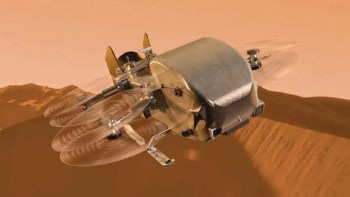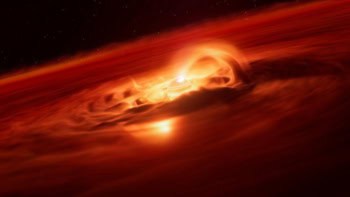
Particle physicists at Fermilab’s Tevatron accelerator in the US have found an exciting new result that could explain one of the big mysteries of cosmology – why there is matter in our universe. The findings come from Fermilab’s D0 experiment, designed to study the precise interactions of protons and antiprotons as they collide at velocities close to the speed of light.
The researchers, led by Guennadi Borissov of Lancaster University in the UK, were looking for a feature known as charge-parity (CP) violation, which helps to explain the fundamental difference between the behaviour of a particle and its antiparticle. It explains why matter survived in the universe after the Big Bang, when matter and antimatter were created in equal amounts and should have annihilated completely.
To catch a glimpse of CP violation, many experimentalists look to the decay of mesons at large B-factory meson experiments such as BELLE in Japan and BABAR in the US. Indeed, the results so far have been consistent with predictions from the Standard Model of particle physics. However, this is not nearly enough to explain the full extent of matter-antimatter asymmetry in the universe and this has sustained a divide between theory and experiment in particle physics.
Spotting the asymmetry
With this latest research, Borissov and his team are finally starting to see a clearer asymmetry by looking to the decay of the neutral mesons, B_s and B_d. Researchers at BELLE and BARBAR have constrained CP violation previously in the decay of B_d mesons but never before in B_s mesons – largely because they have not had access to electron-positron collisions of a sufficient energy to produce these particles. This is now possible at the D0 experiment.
To see whether CP violation is present, the researchers looked to the meson decay products. One complication is that neutral mesons, such as the B_s and B_d, tend to oscillate between their particle and antiparticle making it difficult to tell which meson has decayed. Borrisov’s team can decipher this, however, by looking to the charge of the decay particles.
“Each [meson] could decay into a muon, a neutrino and, say, a charm-flavour meson”, Borissov explains. Asymmetry between the B and anti-B is then measured as an overall preferred charge for the measured muon-pairs, with the final measured asymmetry deviating from the Standard Model prediction by 3.2 standard deviations.
A tricky experiment
Borissov was keen to emphasize, however, that this process was not as straightforward as it sounds, warning that many muons can also result from kaon decays that occur in the experiment. This background is serious because kaons have an artificial preference over anti-kaons for decaying in the D0 detector, so that if they were mistaken for B mesons a fake asymmetry would be seen. The asymmetry in control samples of kaon decays was measured and removed.
Terry Wyatt of University of Manchester, former spokesperson of the D0 experiment, is impressed by the robustness of these results, saying there is only a “one in one thousand” chance of this being a statistical fluctuation. He concedes, however, that more work will need to be carried out to confirm that the deviation is real. “We hope to increase the collected data set by about a factor of 2. In addition, we can hope for improvements in the analysis techniques that could reduce the uncertainty further,” he says.
Perhaps the biggest opportunity to develop these results will come at the LHCb at CERN, another B-physics experiment that can record up to 2000 of these meson decays every second. “For many studies LHCb expects to surpass the sensitivity of the Tevatron experiments rather early in this, the first LHC run, of 2010-11,” says Guy Wilkinson, LHCb’s physics co-ordinator.
Particle physics researcher Tim Gershon of Warwick University believes that B factories like those at Fermilab and CERN are very promising places to look for CP violation. “Results from both CDF and D0 have hinted at new physics effects before, causing great excitement in the community,” he says. “Measurements from the B factories have placed stringent limits on many of the possible deviations from the Standard Model.”
This research is detailed in a preprint on the D0 experiment website.




